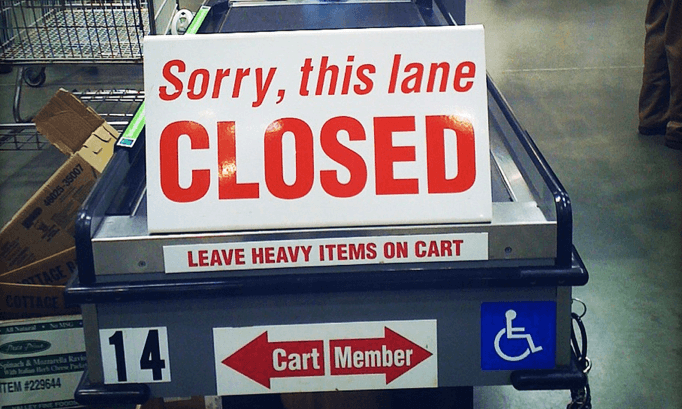
Self-Checkout Meltdown: Why Retail’s Automation Push Is Leaving Shoppers Stuck in Line
Retailers once heralded self-checkout as the ultimate solution to speed and efficiency in stores. Yet in 2025, the reality for many shoppers feels like the exact opposite. Long lines snake through grocery aisles, only one traditional checkout lane is actually open, and what was promised as a quicker, frictionless experience has become an error-prone chore that frustrates both consumers and staff. Far from the sleek tech revolution retailers envisioned, self-checkout has turned into a case study in how rushing to automate can backfire.
The cascading problems start at the front of the store, where some big-box and grocery chains have cut labor so drastically that just one lonely cashier mans the “traditional” lane. Everyone else is funneled to self-checkout kiosks. It looks streamlined at first—until you notice the cluster of machines, each with a frazzled customer wrestling with unscannable produce or misread barcodes. The result: lines that crawl instead of flow.
“I waited 15 minutes at the self-checkout for two items,” says Andrea Bailey, a shopper in suburban Chicago who gave up halfway to join the single staffed lane instead. “No one was around to help unless you shouted for someone. The whole thing was a mess.” She’s not alone. A 2025 Ipsos survey found that 61% of consumers consider self-checkout more time-consuming than a staffed register, up from 53% just two years earlier. The top complaint was a lack of on-hand associates to fix glitches.
For the stores, the pressure to cut costs traces back to the late 2010s, when automation hype soared after Amazon introduced its cashier-less Amazon Go concept. Fearing they might be left behind, chains laid off front-end staff in favor of self-checkout machines. But Amazon Go’s “Just Walk Out” model, which relied on sophisticated sensors and AI, never rolled out at scale for big-box environments—yet many retailers had already doubled down on less-advanced kiosks that require constant monitoring for errors, age-restriction checks, and scanning mishaps.
“Everyone got spooked by Amazon,” says Robert Delaney, a mid-Atlantic regional manager at a prominent grocery chain. “We felt we had to modernize or die. Fast-forward to now, and we’re grappling with huge lines because we replaced cashiers with machines that just don’t work as seamlessly as advertised.”
Ironic, too, is how this shift impacts operating costs. While retailers saved on wages by slashing cashier roles, a 2024 RBC Capital Markets analysis shows a 24% jump in “front-end incidentals”—costs related to lost inventory, returned or damaged items from mis-scans, and security measures to deter theft. One store manager, speaking on condition of anonymity, described it bluntly: “We cut staff to save money, but now half of them are busy babysitting the self-checkout area anyway. We haven’t really saved a dime.”
Shoppers also lament the emotional toll of friction-filled transactions. “We’re not just scanning groceries; we’re juggling error messages and weigh-scale resets,” says Ben Myers, a father of two who found himself assisting his 70-year-old mother-in-law with the kiosk every week. “It’s exhausting. If one item won’t scan, or the machine thinks you haven’t placed it in the bagging area, you’re stuck waiting for an employee to come over—and there’s usually just one person patrolling six machines.”
Even the perceived convenience of self-checkout for small purchases has eroded. A BrightLocal review analysis notes that negative store feedback mentioning “self-checkout frustrations” rose from 9% of complaints in 2022 to 17% in 2024. Meanwhile, a Deloitte study of top grocery chains estimates up to $250,000 in annual lost revenue per store due to customers who either walk out mid-queue or reduce their trip frequency after multiple bad experiences. The intangible damage to brand loyalty—when a simple errand leaves a shopper irate—is harder to measure but undoubtedly real.
So if self-checkout has become such a pain, why do so many retailers stick with it? Some still see untapped potential. In theory, well-maintained kiosks can handle routine transactions quickly, freeing up employees for higher-value tasks like customer service or online order fulfillment. To that end, major retailers are now experimenting with smaller “10 items or fewer” self-check lanes to reduce complexities, AI software that auto-identifies produce without lookup codes, and dedicated “tech ambassadors” who rush to each hiccup. Yet those upgrades demand additional investment and staffing—precisely what many retailers sought to avoid.
“We had visions of frictionless checkouts, minimal staff, and bigger profit margins,” concedes Delaney. “Instead, we’re seeing that if you lay off too many people, you kill the convenience factor and end up frustrating the very customers you’re trying to serve.”
Looking ahead, some experts believe the industry is due for a self-checkout “correction,” where retailers refocus on improving the in-person experience and rebalancing the ratio of manned registers to kiosks. Others predict advanced AI could still salvage the concept, if it can reliably reduce scanning errors and deter theft—though that’s a steep hill to climb. A handful of stores, like Wegmans and H-E-B, have publicly trimmed their self-checkout footprint, reintroducing staffed express lanes during peak hours and reporting higher satisfaction scores as a result.
For consumers, the short-term takeaway seems clear: expect fewer cashiers, more kiosk queues, and the added tension of dealing with finicky machines. Until retailers strike a better balance, you may want to allow extra time for your shopping run—or head to an old-school store that still prioritizes enough staff to keep lines moving. Because if automation was supposed to be the future, it looks like the present is more about slow lanes, scanner errors, and a collective longing for the days when a human cashier could handle your groceries in a snap.